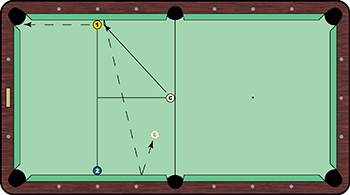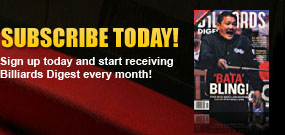A great drill to check your game and understand your equipment.
Part of the growth process in pool is gaining a better understanding of your cue and stroke. Understanding deflection is important in having better control on the variety of shots that pop up in every game. Here is a great drill that looks easy but is very effective. Itís a drill that requires stroke, inside and outside English, and touch with and without English. I got this drill from former Team Europe coach Johan Ruysink a long time ago, and I practice this drill whenever I get a new cue, shaft or tip. This drill will give you great feedback about your equipment.
As shown in the diagram, freeze both object balls to the rail and try to pocket as many consecutively as you can while keeping the cue ball within the confines of the boxes (the area between the center of the side pockets and the second diamond, and left of the center line for shots on that side of the table and vice versa for the other side). It is not as easy as it looks. Some shots will require a soft punch, some with English, some without, sometimes a harder stroke. It all depends on the angle you leave for each shot. I usually try to play a lot of medium soft shots with English, like quitting on the shot. Itís a touchy-feely drill that requires a lot of concentration.
Again, you will get a lot of feedback about your tip and deflection because itís easy to twist your grip hand on release. Itís also easy to jump up from the cue. You need smooth and sound fundamentals for this. Most players will tend to lift up their head and over spin the cue ball. The cue ball ends up hitting the rail before the object ball, and that leads to quitting on the shot. Neither the cue ball nor the object ball will do what you want it to do. Remember to stay with the shot and use a smooth stroke. When you get anxious, your grip hand tends to choke the butt end of the cue too hard, which results in overhitting the ball and getting into the cue ball too much. That will often result in scratching into a side pocket. Again, this drill will help you understand the feel and stroke, and give feedback about your equipment. Trust your shaft and tip.

At the beginning, you can use the entire width of the table if youíd like. You may land straight in on your next shot, which would require a power punch shot to get back across the table. I do it both ways. Either way, however, the cue ball must not pass the center of the table. Keep replacing the balls on each side of the table and count how many you can make in a row. Shoot for 10 in a row. Thatís a good starting goal and a good standard for amateur pool. If you start making 20-30 in a row, your level is top notch. Anything over 30 and you are reaching a pro-level standard.
I try to play most shots with center ball or slightly below center, depending on the angle. Iíll use a little English if there is a bigger angle on the shot, but the keys are still a steady head, a smooth stroke and a nice loose grip. Donít quit on the shot and your timing will be improved immediately.
I bring up this drill in large part because so many people ask me what tip and shaft I play with and ask what I think they should use. Personally, I think most amateurs should start with a soft/medium tip and go from there. Everyone has a different stroke and delivery, so itís difficult to just blindly recommend one tip or shaft to an amateur. But a drill like this will give you the feedback you need to understand how different tips and shafts affect deflection because of the shots required. Once you are comfortable with this drill, youíll know a lot more about your preference for tips and shafts. Simple drill, but one that you will learn a lot from.





